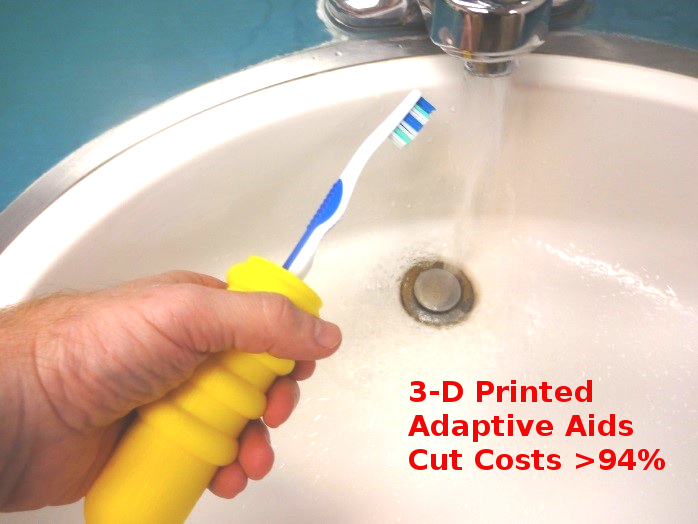![[Image: MTU]](https://fabbaloo.com/wp-content/uploads/2020/05/geriatrics-03-00089-ag_img_5eb0a0f46e160.png)
Assistive devices are typically small aids that make a big difference — and often at a big cost.
Michigan Tech’s open source champion, Dr. Joshua Pearce, has published papers and taught classes showcasing the accessibility and affordability of open source (RepRap) 3D printers not for their own sake, but to cut costs in everyday activities. Citing CDC reports that nearly 25% of the US population is affected by arthritis in some form, the latest research to appear from Professor Pearce’s team highlights an impressive finding: 3D printing can save more than 94% on costs for household adaptive aids.
Working with his students to ultimately redesign and 3D print 20 assistive devices, the classroom started from scratch. The first two weeks of the course saw students building their own RepRap 3D printers; the adaptive aid assignment saw a one-week turnaround for new handheld items 3D printed in PLA.
Life doesn’t slow down because dexterity is a challenge. Pills need to be split, phones need to be held, nails need to be clipped. A $23.75 pill splitter could instead be 3D printed for $1.27, while a phone holder retailing for $49.99 could be replaced with a 3D printed device and a rubber band totaling to $0.79.
“This is the difference between needing to go to someone to get your nails cut and being able to do your own, which, yes, there’s cost savings, but it’s also personal pride and being able to take care of yourself. And if your only problem is that the standard nail clipper is too tiny, we can fix that,” said Pearce.
The classroom work and student projects culminated in a paper co-authored by student research assistant Nicole Gallup, orthopedic surgeon Jennifer Bow, and Pearce.
The 20 designs made 3D printable in this research are online now; all are open source and available for download, customization, and 3D printing.
![Some of the MTU designs for 3D printed assistive devices [Image: MTU via Appropedia]](https://fabbaloo.com/wp-content/uploads/2020/05/mtuaids_img_5eb0a0f502548.png)
“We printed and analyzed 20 different products and each one has a great return on investment, even for people who can use insurance to purchase adaptive aids with a co-pay, and a printer pays for itself easily. It’s a slam dunk — but the question becomes how do people get these aids?” Pearce continued.
While desktop 3D printers are more accessible than ever, especially with the RepRap project opening up the DIY segment for lower-cost machines, 3D printing is never going to be for everyone. Consumer 3D printing has been a contested topic for years, with renewed vigor following more accessibility, but many of those who could most benefit from, say, assistive devices aren’t exactly the demographic who will be turning to OpenSCAD to take on the MTU designs. Pearce and his team acknowledge this reality, of course. The future of distributed manufacturing is as yet in flux, but if desktop 3D printers began to appear in more care facilities, like nursing homes, doctors’ offices, and physical therapy clinics, access to adaptive aids could drastically increase. For now, makerspaces and libraries are some of the best options for local access to 3D printers and operators who know how to use them.
Healthcare usage of 3D printers is on the rise, with more and more hospitals turning to validated solutions for patient-specific 3D printing. Much of this is fairly deep usage, though; multi-material complex prints of tumors is a bit beyond plastic lightswitch covers. Theoretically, creating smaller personal items for home use should be easier (and much, much cheaper) than the complicated prints emerging from hospital labs. These latter potentially-life-saving uses are much more attention-grabbing, but it does help to remember that 3D printing comes in a variety of sizes and materials, and the place of desktop 3D printing with basic materials like PLA retains a place in common usage.
With communities coming together to create design challenges and universities exploring the impact of DIY to help those, desktop 3D printing can help remove pain points in pain management and adaptation.
Via MTU











FELIXprinters has released a new bioprinter, the FELIX BIOprinter, which is quite a change for the long-time 3D printer manufacturer.